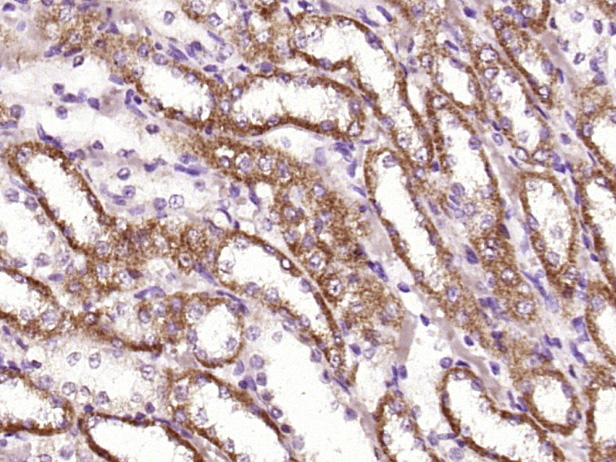
Rabbit Anti-DPP1 antibody
cathepsin C light chain; Dipeptidyl peptidase I; AI047818; CATC; Cathepsin C; Cathepsin J; CPPI; CTSC; Dipeptidyl peptidase 1; Dipeptidyl transferase; DPP I; DPPI; EC 3.4.14.1; HMS; JP; JPD; MGC126959; PALS; PLS; DPP-I; DPPI.
View History [Clear]
Details
Product Name DPP1 Chinese Name 组织蛋白酶C抗体 Alias cathepsin C light chain; Dipeptidyl peptidase I; AI047818; CATC; Cathepsin C; Cathepsin J; CPPI; CTSC; Dipeptidyl peptidase 1; Dipeptidyl transferase; DPP I; DPPI; EC 3.4.14.1; HMS; JP; JPD; MGC126959; PALS; PLS; DPP-I; DPPI. Research Area Synthesis and Degradation Immunogen Species Rabbit Clonality Polyclonal React Species Rat, (predicted: Human, Mouse, Chicken, Dog, Pig, Cow, Horse, Rabbit, ) Applications WB=1:500-2000 ELISA=1:5000-10000 IHC-P=1:100-500 IHC-F=1:100-500 IF=1:100-500 (Paraffin sections need antigen repair)
not yet tested in other applications.
optimal dilutions/concentrations should be determined by the end user.Theoretical molecular weight 8/52kDa Cellular localization cytoplasmic Form Liquid Concentration 1mg/ml immunogen KLH conjugated synthetic peptide derived from human cathepsin C light chain: 365-463/463 Lsotype IgG Purification affinity purified by Protein A Buffer Solution 0.01M TBS(pH7.4) with 1% BSA, 0.03% Proclin300 and 50% Glycerol. Storage Shipped at 4℃. Store at -20 °C for one year. Avoid repeated freeze/thaw cycles. Attention This product as supplied is intended for research use only, not for use in human, therapeutic or diagnostic applications. PubMed PubMed Product Detail The protein encoded by this gene, a member of the peptidase C1 family, is a lysosomal cysteine proteinase that appears to be a central coordinator for activation of many serine proteinases in immune/inflammatory cells. It is composed of a dimer of disulfide-linked heavy and light chains, both produced from a single protein precursor, and a residual portion of the propeptide acts as an intramolecular chaperone for the folding and stabilization of the mature enzyme. This enzyme requires chloride ions for activity and can degrade glucagon. Defects in the encoded protein have been shown to be a cause of Papillon-Lefevre syndrome, an autosomal recessive disorder characterized by palmoplantar keratosis and periodontitis. Multiple transcript variants encoding different isoforms have been found for this gene. [provided by RefSeq].
Function:
Thiol protease. Has dipeptidylpeptidase activity. Active against a broad range of dipeptide substrates composed of both polar and hydrophobic amino acids. Proline cannot occupy the P1 position and arginine cannot occupy the P2 position of the substrate. Can act as both an exopeptidase and endopeptidase. Activates serine proteases such as elastase, cathepsin G and granzymes A and B. Can also activate neuraminidase and factor XIII.
Subunit:
Tetramer of heterotrimers consisting of exclusion domain, heavy- and light chains.
Subcellular Location:
Lysosome.
Tissue Specificity:
Ubiquitous. Highly expressed in lung, kidney and placenta. Detected at intermediate levels in colon, small intestine, spleen and pancreas.
Post-translational modifications:
N-glycosylated. While glycosylation at Asn-53, Asn-119 and Asn-276 is mediated by STT3A-containing complexes, glycosylation at Asn-29 is mediated STT3B-containing complexes.
In approximately 50% of the complexes the exclusion domain is cleaved at position 58 or 61. The two parts of the exclusion domain are held together by a disulfide bond.
DISEASE:
Papillon-Lefevre syndrome (PLS) [MIM:245000]: An autosomal recessive disorder characterized by palmoplantar keratosis and severe periodontitis affecting deciduous and permanent dentitions and resulting in premature tooth loss. The palmoplantar keratotic phenotype vary from mild psoriasiform scaly skin to overt hyperkeratosis. Keratosis also affects other sites such as elbows and knees. Note=The disease is caused by mutations affecting the gene represented in this entry.
Haim-Munk syndrome (HMS) [MIM:245010]: An autosomal recessive disorder characterized by palmoplantar keratosis, onychogryphosis and periodontitis. Additional features are pes planus, arachnodactyly, and acroosteolysis. Note=The disease is caused by mutations affecting the gene represented in this entry.
Periodontititis, aggressive, 1 (AP1) [MIM:170650]: A disease characterized by severe and protracted gingival infections, generalized or localized, leading to tooth loss. Amounts of microbial deposits are generally inconsistent with the severity of periodontal tissue destruction and the progression of attachment and bone loss may be self arresting. Note=The disease is caused by mutations affecting the gene represented in this entry.
Similarity:
Belongs to the peptidase C1 family.
SWISS:
P53634
Gene ID:
1075
Database links:Entrez Gene: 1075 Human
Omim: 602365 Human
SwissProt: P53634 Human
Unigene: 128065 Human
Product Picture
References (0)
No References
Bought notes(bought amounts latest0)
No one bought this product
User Comment(Total0User Comment Num)
- No comment



 +86 571 56623320
+86 571 56623320
 +86 18668110335
+86 18668110335

